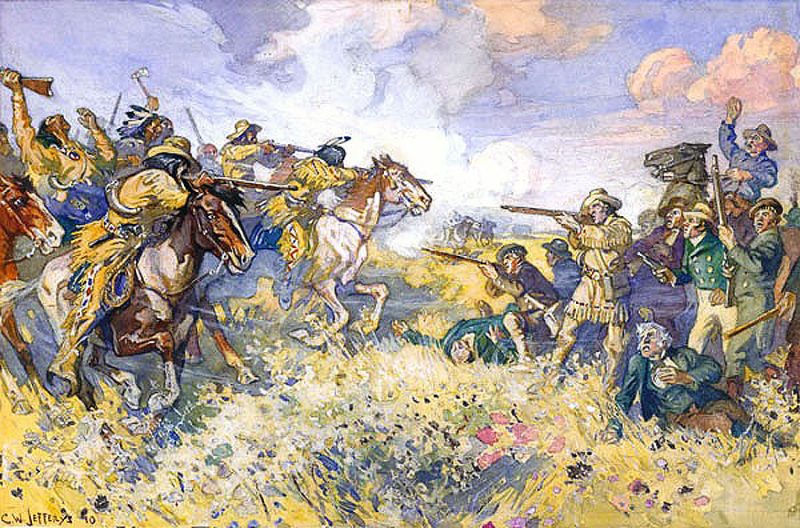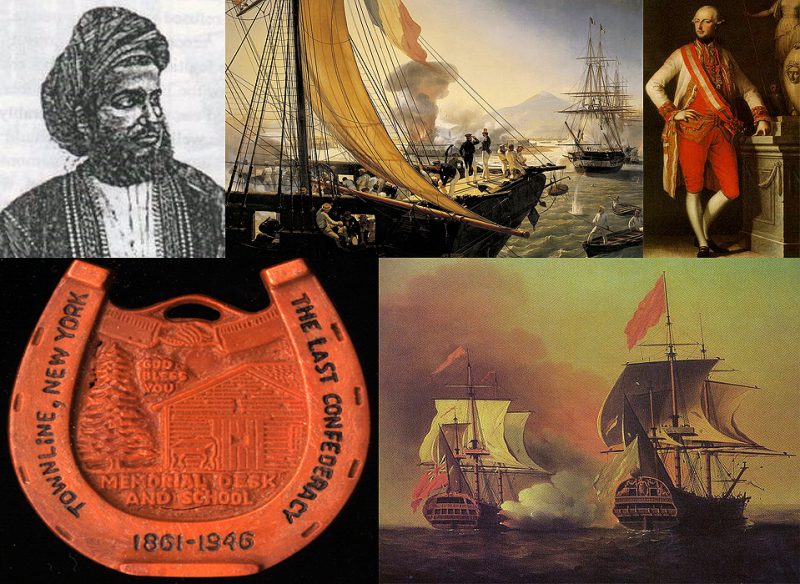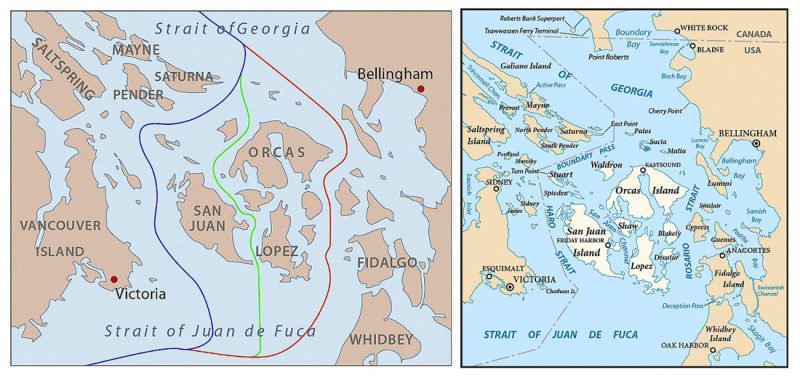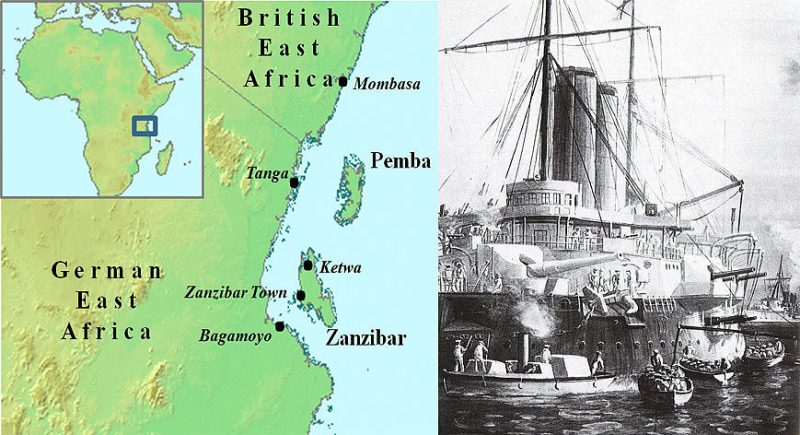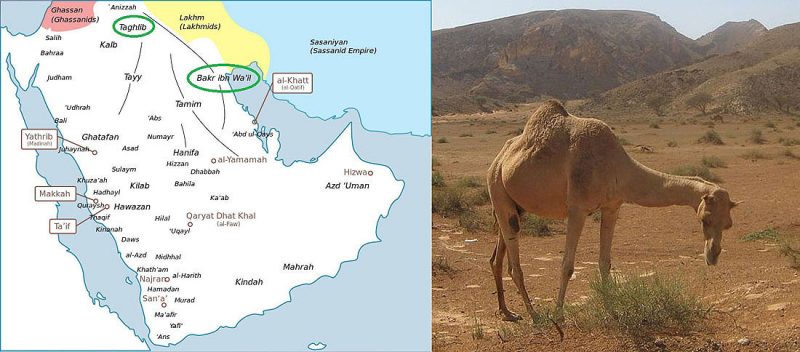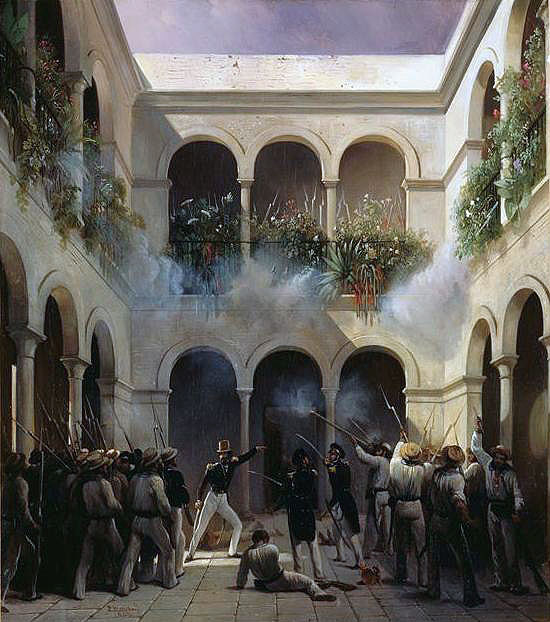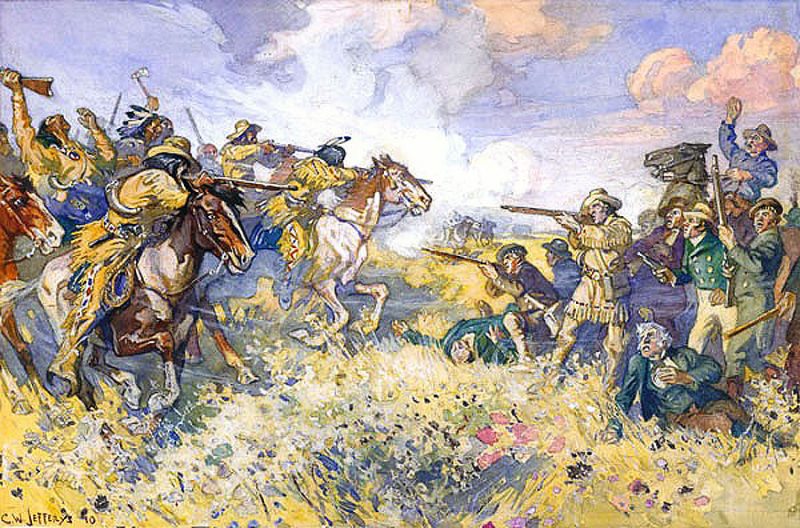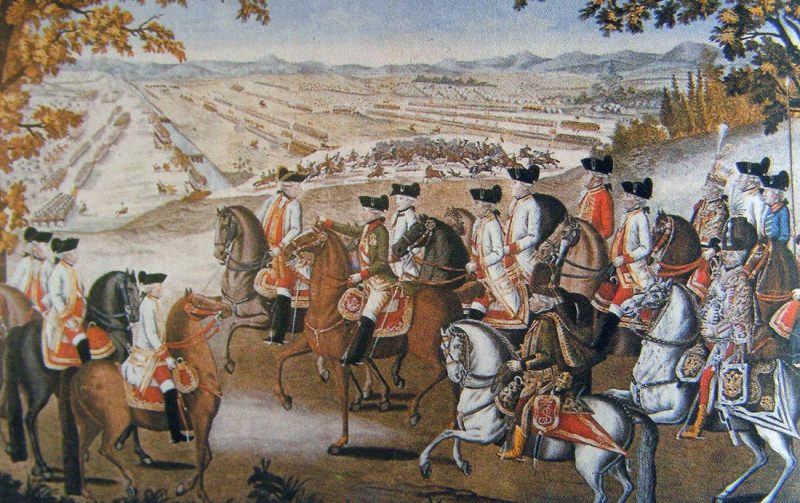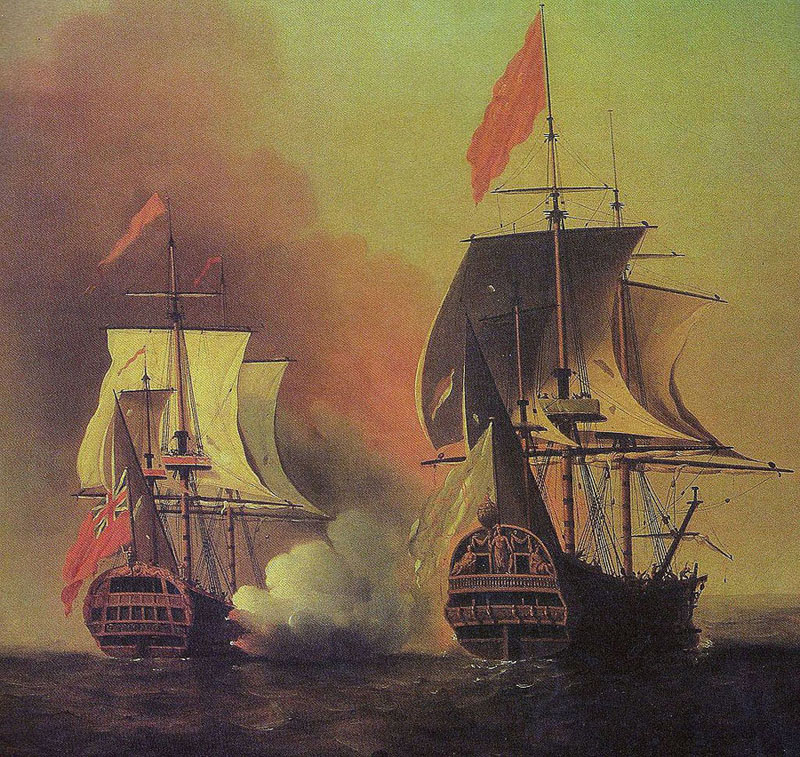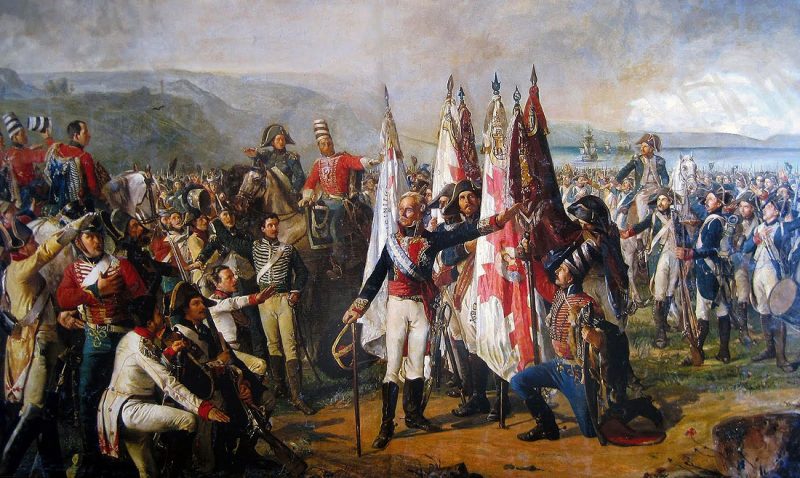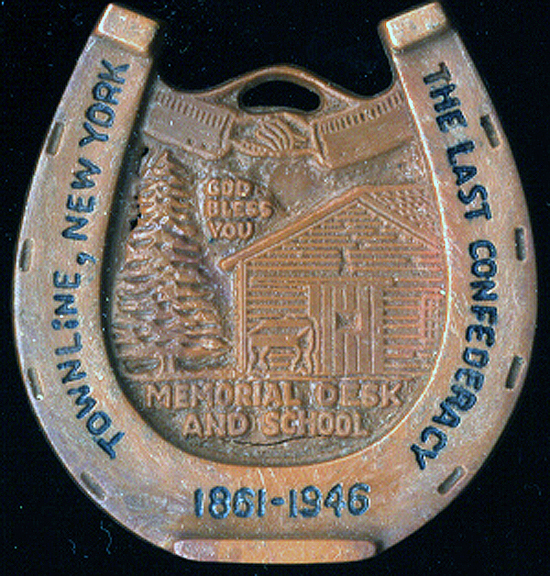Images used (Clockwise from top left): (1) Sultan Kalid Barghash of Zazibar who ruled from August 25 to August 27, 1896 (2) The French forces bombing and capturing the Mexican fortress of San Juan de Ulúa in 1838 (3) Holy Roman Emperor of the late 1700s, Joseph II, initiator of the Kettle War (4) A British Warship (Left) capturing a Spanish trading ship in 1743 during The War of Jenkin’s Ear, painted by a British painter Samuel Scott (5) Town Line, A Town in New York calls itself ‘the last Confederacy’
War can be defined as an organized and often extended conflict between states or non-state entities. Some people would consider war as a serious and glorious struggle over some important issues. But there had been unconventional wars in the history of mankind that could be termed as huge wastes of time. 10 such senseless wars had been ranked by io9,
(10) Decade-Long Dual Occupation of San Juan Islands Known as ‘Pig War’ (June 15, 1859 to 1874):
It was a war that saw no human casualties and no shots exchanged between the belligerents. It was rather a confrontation between the British Empire and the United States over the boundary and occupation of San Juan Islands, which lie between North American mainland and Vancouver Island. The Oregon Treaty between the two sides in 1846 could not resolve the ambiguity over the water boundary and both United States and Britain claimed sovereignty over the San Juan Islands.
Images used (from left): (1) Boundary dispute at San Juan Islands between US and British Authorities in Canada during the Oregon Treaty of 1846 and during the Pig War, the blue boundary line is favored by the US, red boundary line favored by Britain, green boundary line through San Juan Channel was the compromised proposal (2) Map of San Juan Islands today, all of it part of United States
By mid 1859, a British company named ‘Hudson’s Bay’ started operating on this island with sheep ranches. At the same time about 25 to 29 American settlers had been living there for nearly fifteen years. American settlers had moved onto the island and claimed rights to live there under the American ‘Donation Land Claim Act’. The Island was strategically important for its location. The tantrums over pig started on June 15, 1859. An American farmer Lyman Cutlar found a large black pig rooting in his garden and eating his tubers. It was not the first occurrence. An upset Cutlar took aim and the pig was shot dead. It turned out that an Irishman and employee of the British Hudson’s Bay Company, Charles Griffin, owned the pig. Cutler offered $10 to Griffin as compensation but Griffin demanded $100. Following the dispute, the British authorities threatened to arrest Cutlar. And the American settlers called for military protection.
To prevent the British forces from landing, initially 66 American soldiers were sent to the island from Oregon. To keep the Americans in check and to continue British occupation on San Juan Island, the British sent 3 warships and a group of marines. By August 10, 1959, 461 American soldiers were deployed with 14 cannons opposed by 5 British warships with 70 mounted cannons and 2,140 combatants on board. Not a single shot was fired though!
British Navy received orders from Vancouver Islands to land on San Juan Island and to strike the American soldiers. But British Rear Admiral Robert Baynes refused, coming to conclusion that it was foolish enough for two great nations to engage in a war over a dispute about a pig. Both sides were carrying out the same orders of defending oneself but under no circumstances firing the first shot. Other than exchanging insults, no shots were ultimately fired between the two forces.
Despite the intervention of US President James Buchanan, the muscle flexing between the two nations continued for the next 12 years. It took six weeks to argue the British to reduce their forces down to one warship, and for that a group of British marines had to be allowed to establish camp on the island. Eventually San Juan Island went to United States, amidst disapproval of Canadian politicians and public who had been accusing Britain for not looking after Canadian interests in case of the Oregon Treaty and San Juan Island issue and Canada sought more autonomy in international matters.
(9) Anglo-Zanzibar War, the Shortest War in History (August 27, 1896):
Sultanate of Zanzibar, which is part of Tanzania in East Africa since 1964, was a protectorate of the United Kingdom between 1856 and 1964. When a pro-British former sultan of Zanzibar, Hamad bin Thuwaini died on August 25, 1896, his nephew Khalid bin Barghash seized power in Zanzibar. However, the British authorities preferred Hamud bin Muhammed, son-in-law of first Sultan of Zanzibar as Hamud was more supportive to British interests. According to an 1886 treaty, candidates to become sultan of Zanzibar must obtain permission from British consul and Khalid violated this requirement. The British considered it as ‘Casus belli’ (Latin phrase meaning ‘an event or act that provokes or justifies war’) and gave an ultimatum to Khalid demanding he along with his forces to step down and leave the palace by 09:00 AM East Africa Time on August 27, 1896.
Images used (from left): (1) Map during Anglo-Zanzibar War of 1896 showing location of British East Africa, German East Africa and Zanzibar’s location related to Africa (2) London news illustrated two British Cruisers HMS St George and HMS Philomel during the war
In response, Khalid barricaded himself inside the palace, called up his palace guards and gathered 2,800 combatants, 4 artillery pieces, 1 shoe battery, a royal yacht and two boats. By the time the ultimatum expired, the British had prepared three cruisers, 150 marines and sailors, two gunboats and 900 Zanzibari combatants. 2 minutes after the ultimatum period was over, the British started shelling Khalid’s Palace and harem disabling the palace artillery, 1 shore battery and sinking the royal yacht and Khalid’s two boats. Within 38 minutes, at 9:40 AM, flag at Khalid’s palace was shot down and firing ceased. 500 of Khalid’s soldiers were killed or wounded while only 1 British sailor was wounded. According to Guinness Book of World Records, the Anglo-Zanzibar War was the shortest war in history with the duration of the war being between 38 minutes and 45 minutes.
After that, Khalid fled and took asylum in the German consulate. The Germans arranged for him to live in exile in German controlled East Africa (now Burundi and Rwanda). Khalid’s exile wasn’t even good enough for the British authorities. When the pro-British sultan Hamud, who was installed in Zanzibar by the British authorities, died in 1902, the British wanted to make sure Khalid wouldn’t try to grab the throne again. They demanded Germany to hand him over. Khalid had been secretly fleeing for the next fourteen years from the pursuing British forces and was captured by them in 1916 and was subsequently exiled to the Seychelles and Saint Helena. By the 1920s, he was allowed to return to East Africa by the British authorities and Khalid died in Mombasa in 1927.
(8) Al-Basus War Becomes an Aphorism and a Reference for Useless War (from 494-534 AD):
Surprisingly, a dispute between two clans in medieval Saudi Arab over a camel resulted in a 40 year long perpetual cycle of vengeance. North Arabian tribe Banu Taghlib and Banu Bakr ibn Wail engaged in the 40 year war before Islam.
Images used (from left): (1) Map of Arabian Peninsula and approximate locations of major Saudi Arabian tribes at the dawn of Islam (2) Al-Basus War sparked over killing a she-camel
The war is named after an old woman, Al Basus. It all started when a she-camel owned by the neighbor of Al Basus wandered and mingled with the herd belonging to chief of Banu Taghlib tribe. Not recognizing the camel the chief killed the she-camel. Nephew of Al Basus was the leader of Banu Bakr tribe and upon hearing this he killed the chief of Banu Taghlib. The war dragged on for ages and there wasn’t any clear winner. Even in present time, in parts of the Arab world, the example of Basus War is used to warn people against vendettas.
(7) The Cod Wars Were Not Worth the International Mockery (1958, 1972-73, 1975-76):
The cod wars were political disputes over fisheries management in Icelandic maritime waters between the governments of Britain and Iceland. The war could be counted as even four considering the dispute in 1950 when Iceland moved its territorial waters up to 4 miles much to the displeasure of Britain since the British utilized the fisheries in the Icelandic region. The British fishermen could not fish as much as before because of the four mile limit. In 1958, the territorial waters were moved from 4 to 12 miles by Iceland according to UN Geneva Convention on Laws of the Sea. Britain declared that their fishing trawlers would fish in three Icelandic areas under protection of British warships. Navy joined in the conflict and soon many incidents followed.
Images used (from left): (1) During the first Cod War in 1958, British Trawler Coventry City passing Icelandic Coast Guard Patrol vessel Albert off the Westfjords Peninsula, Iceland (2) Icelandic Coast Guard Patrol vessel Odinn (in front) and British frigate HMS Scylla (behind) clash in the North Atlantic during the third Cod war
In February 1960, minister responsible for Royal Navy, Lord Carrington said that total 53 British warships had taken part in operations since 1958 and had expended oil worth half a million pounds sterling. Against this, Iceland could deploy only 7 Patrol vessels and a single PBY Catalina flying boat. In one incident, Iceland’s Patrol vessel ICGV Ægir attempted to take a British trawler off Icelandic coastal area but was thwarted by British anti-submarine frigate HMS Russell. As a result, Ægir and Russell collided. Another Icelandic ship forced a British fishing boat out of Icelandic waters and fired upon it, before being chased back by several British warships. 7,000 British sailors were deployed around Icelandic waters. The amount of fish Britain got was far below the military cost and was not worth the international mockery. The series of Cod wars finally ended in 1976 after Britain accepted Iceland’s right over a 200 nautical-mile exclusive fishery zone in the Icelandic waters.
(6) Pastry War Fought between Three Nations (November 27, 1838 to March 9, 1839):
The Pastry War is also known as the First Franco-Mexican War. There was widespread civil disorder in the new Mexican republic in 1828. The conflicting powers to grab the presidency of Mexico destroyed a great deal of public and private properties of the residents. There were no consuls in Mexico and foreigners whose property was destroyed or looted by the rioters were unable to obtain any compensation from any Governments. The French Government was not paying heed to the claims from French nationals in Mexico. However, a French pastry cook, Remontel appealed to the King Louis-Philippe of France as his shop in a district of Mexico City had been looted by Mexican officers in 1828. Coming to a French national’s aid, France demanded 600,000 pesos in damages from Mexico. It was quite a big sum as at that time the typical daily wage in Mexico City was only about one peso. Moreover, Mexican Government also had defaulted on loans from France worth millions of dollars.
When Mexican president Anastasio Bustamante refused to make payment, French forces captured almost the entire Mexican navy and blockaded the ports. Mexico also announced war on France. Mexico had 3,239 combatants and was supported by United Kingdom while France had 3,000 combatants and was supported by USA and the then Republic of Texas. After the Texan revolution, bloody war between The Republic of Texas and Mexico and the subsequent secession of Texas from Mexico in 1936, there was no surprise that the Texan forces would fight off Mexican smugglers smuggling imports via Republic of Texas during the French blockade of Mexican ports. Meanwhile, United States sent a schooner USRC Woodbury against Mexico and to help the French become successful in the blockade.
Image used: French troops lead by King Philippe’s 3rd son Prince de Joinville attacking residence of leading Mexican General Arista in Veracruz, Mexico in 1838.
8 French combatants died and 60 more were wounded while 224 Mexican combatants died in the war. The war ignited up by a French baker’s compensation claim ended up through the diplomatic intervention of United Kingdom and eventually Mexican President agreed to pay the 600,000 pesos to compensate the victim baker. The French forces withdrew their fleet on March 9, 1839.
(5) Corporate Wars Were Proved to Be Pointless During the Pemmican War (1812 to 1821):
It was a series of armed conflicts at Red River Colony (consisting of parts of present day Manitoba, Minnesota and North Dakota) between two fur trading companies, the North West Company (NWC) and Hudson’s Bay Company (HBC) during the lucrative North American animal fur trade. ‘Pemmican’ was a Native American food consisting of a mixture of dried (buffalo, bison, moose, deer or elk) meat mixed with animal fat and dried berries and sold in a leather bag. The Hudson’s Bay Company was granted a charter by the British Authorities and got an early lead, but the North West Company became an archrival of HBC and was gaining market share.
In 1811, the Red River Colony was established by 5th Earl of Selkirk, Thomas Douglas, who had a controlling power in the HBC and wanted to block NWC‘s trading in the area. Following a food shortage in the Red River Colony in 1814, Governor of the colony issued Pemmican Proclamation at Fort Douglas, which forbade the colony residents (mostly the Metis Indians) to sell meats and furs outside of the colony. Mostly affected were the members of the North West Company who accused the Hudson’s Bay Company behind such restrictions to monopolize the HBC’s trade in the region.
The Metis Indians did not take the free-market stifling measures easily and they attacked fort Douglas twice by 1815. In 1816, a group of Metis stole a Pemmican supply from HBC and offered the NWC to buy the loot. The new Governor of the Colony chased the Indians and a great gunfight called ‘Battle of Seven Oaks’ ensued.
Image used: Illustration of the Battle of Seven Oaks on June 19, 1816, during the Pemmican War in the region
The Governor fired the first shot. The Matis, being excellent marksmen, quickly defeated the Governor, killing 22 including the Governor himself. The Metis suffered only 2 casualties. It was a victory for the Metis, for free market capitalism and for the North West Company. For the next four years, the two archrival companies raided, blockaded and raised armies against each other. All that for some dried meat, fats and berries. On the face of declining profits and pressure from the British authorities to settle disputes, these two trading companies were merged into a single one in 1821.
(4) The Humiliating Kettle War (October 8, 1784):
This war was humiliating because the stronger party was easily defeated with just one shot fired by the comparatively weaker side and that shot hit a soup kettle. Netherlands was divided into two territories in 1784. The Kettle war was a military conflict between the combatants of The Northern Netherlands or the Republic of the Seven Netherlands and the Austrian Netherlands backed by the Holy Roman Empire. Joseph II was the Holy Roman Emperor.
Belgium was at that time controlled by Austria. After the Dutch Revolt from 1566 to 1646, Northern Netherlands or Republic of the Seven Netherlands became Independent from the Spanish and Holy Roman Empire. In 1585, the Northern Netherlands had closed off the 350 km long Scheldt River that flows through southwestern Netherlands, western Belgium and northern France. The intention was to cut off the Belgian trading harbors of Ghent and Antwerp.
Joseph II demanded reopening of Scheldt River and sent three warships including the new merchant flagship Le Louis with the Emperor’s flag from Antwerp. Joseph II and his Austrian side did not expect the Dutch to react. The Admiralty of Zeeland, the westernmost province of the Seven Netherlands, sent out the Dutch ship the Dolfijn. The Dolfijin fired only one shot that hit no one but a soup kettle on the deck of Le Louis and Le Louis surrendered. Joseph II declared war on October 30, 1784 but nothing significant happened. In 1785, a treaty between the two nations was signed and Scheldt remained closed.
Image used: Illustration of Emperor of Austria, Joseph II and his soldiers in 1787, soon after losing the Kettle War on October 8, 1784
(3) The War of Jenkin’s Ear Proves That Outrage Only Complicates Things (1739 to 1748):
Since the treaty in 1713 after War of the Spanish Succession, British traders and smugglers were given right to supply 500 tons of goods per year and an unlimited number of slaves to Spanish colonies and a potential inroads into Spanish American markets. But even during this period, Spain and Britain were often at war. Following the Anglo-Spanish War, a 1729 Treaty of Seville allowed the Spanish Warships to check British ships to verify if the British traders were respecting the terms of the treaty of 1713.
In 1731, Spanish patrol boat La Isabela boarded British brig Rebecca. Spanish commander Julio Fandino accused Rebecca’s captain, Robert Jenkins of smuggling and cut off left ear of Jenkins. Fandino told Jenkins to tell the British King that he would repeat such punishment to British Sailors, if the King dared to smuggle. Jenkins was ordered to testify before British Parliament in March, 1738. Jenkins produced his severed and dried ear to Parliament and retribution was demanded from the outraged English public. Diplomatic attempts between Britain and Spain failed and 9 year long The War of Jenkin’s Ear started in 1739.
Location of the War was Florida-Gerogia, New Granada, the Caribbean, Pacific and Atlantic. It was hard for both sides.
Image used: British painter Samuel Scott’s Illustration of a British Warship (Left) commanded by Commodore George Anson capturing a Manila galleon (Spanish trading ship) in 1743 during The War of Jenkin’s Ear
The British forces were weakened by disease in Colombia, defeated in the Caribbean and were driven back from Venezuela. The British captured an important town but lost it after three weeks. The Spanish also could not grasp any British territory. 20,000 British combatants were dead, wounded, captured or missing and 407 British ships were lost. The Spanish lost 186 ships and 4,500 combatants with 5,000 more soldiers wounded. So much over a dried ear!
(2) The 172 Year Long Bloodless War Between Denmark and a Municipality in Spain (1809 to 1981):
Surprisingly enough, Denmark was at war with Huéscar, a municipality in Spain for 172 years. Napoleon was declaring war on almost everyone in the early 1800s. Denmark supported France and the French leader. On the other hand, Britain, Portugal and Spain allied to try to defeat Napoleon.
However, official Spanish alliance was with Napoleon as Charles IV of Spain had signed a treaty with France in 1796 to back each other. In 1807, Spain also sent 13,000 soldiers to Denmark to support the French-Danish cause as the Danish people were worried that while Denmark was weakened by Dano-Swedish War of 1808-1809, Britain would declare war on Denmark.
There was an uprising in Spain in 1808 and Charles IV was abdicated. The 13,000 Spanish soldiers in Denmark were in a difficult situation. In case, new Spanish authority join Britain and Portugal against France and Denmark, Napoleon split the Spanish troops in Denmark into small groups and forcefully made them swear loyalty oath to France.
Image used: In the Napoleonic Wars, Denmark actually tried to remain neutral and traded with both the United Kingdom and France. The Spanish Division of the North was sent to fight the British in Denmark. Illustration of Spanish troops of the Marquis de la Romana pledging to side with the British and turn against France in 1808
All part of Spain took this move of Napoleon angrily and in 1809, Huéscar, the Spanish municipality took it upon themselves. Huéscar declared war on Denmark due to Danish support of French Empire. But the lone municipality couldn’t prepare soldiers or supplies to do anything significant and then forgot about it soon. In 1981, a local historian in Huéscar discovered the official declaration of war. On November 11, 1981, Huéscar city mayor and the Ambassador of Denmark signed a peace treaty too to end the 172 year long bloodless war where not a single shot was fired.
(1) Town Line, A Town in New York That Had a 85 Year Long Civil War of Words With the United States (1861 to 1946):
In 1861, United States had total 34 states and 7 of these, mostly Southern states where slavery was still partially legal, declared their secession from the Union, formed Confederate States of America and sought independence for the Confederacy. The Confederacy wanted to expand the slavery while the Union was restricting it. The civil war began and after 4 years of bloody conflict and death of over 600,000 Union and Confederate soldiers, Confederacy lost and slavery was abolished.
Pledging alliance with the confederacy in 1961, Town Line in New York had, as a town, voted to secede from the Union. The town had only 300 residents and 125 eligible voters reportedly gathered and voted 80 to 45 for secession. 20 people of the town fought for the Union while only 5 residents fought for the Confederacy. Few families in the town fled to Canada to avoid the American Civil War. Because Town Line was not an incorporated municipal entity, their resolution had no legal effect. Neither side of the civil war formally recognized the action of Town Line. However, the town unofficially remained seceded from the United States.
The small New York town became quite unpopular when the 1861 events were discovered by reporters. After the Second World War, the issue was rekindled by reporters making the town more unpopular amidst strong American nationalism. In 1945, cards and letters were sent to Town Line including one from President Truman. In January 1946, the town finally voted 90 to 23 to ‘rejoin’ the Union. Even famous American actor Cesar Romero was present to count the ballots of the election.
Confederate insignia is still part of the Firefighter uniforms in Town Line and the town still calls itself ‘the last Confederacy’.
Image used: Town Line, a Town in New York ‘unofficially’ remained seceded from the United States from 1861 to 1946.
